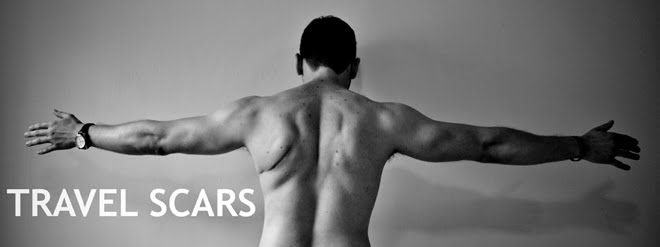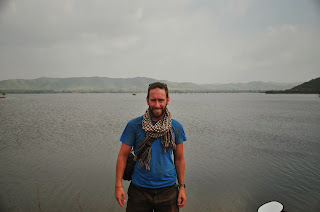Following a brief stopover in Phnom Penh, we finally arrived in Kampot well after dark.
We had reserved a room at Ganesha Guesthouse (www.ganesharesort.com): a French-owned place by a stoner and his wife, situated several kilometers outside of the city center, next to the Kampot river.
Upon leaving the bus, two mototaxi drivers assured us they knew where it was and loaded our big packs between their knees and started to speed down the main road, turning off onto a dirt path into the jungle.
I was pretty sure I had seen a sign saying Ganesha but I assumed they knew where they were going.
At one point they seemed pretty confused and asked for directions. We approached another sign saying Ganesha and started to follow it down an extremely narrow path with palm trees flanking both sides, no lighting, and seemingly no indication that Ganesha was anywhere close by.
At one point, the trail became so precarious that Josh had to get off his bike and walk next to the driver.
It was at this point that I told them about the other sign I had seen and that it would be a good move if we went back to where we started.
With the help of a local woman, we found the original sign and eventually found Ganesha hidden deep in the jungle.
They knew where it was my ass!
Kampot is a quaint riverside town with a laid-back feel with French heritage buildings and a beyond-beautiful countryside. It is also famed, and rightly so, for its out-of-this-world pepper.
Since most points of interest were outside of the city, and even Ganesha itself was a less than convenient distance from the center of town; we would rent scooters to make our lives easier.
Our first destination was Kep, a seaside town around 25km from Kampot.
Although it was situated on the Gulf of Thailand, it really didn't have much beach to speak of, but what it lacked in beach, it more than made up for in seafood.
Josh and I had been recommended a restaurant right by the market and indulged in a huge plate of sublime pepper crab, infused with Kampot's deservedly famous and beyond delicious pepper.
From there we attempted to find one of Kampot's pepper plantations but ultimately couldn't find one. So instead, we just drove around aimlessly, taking random roads to our heart's desire.
At one point, a woman asked for a lift to a wat up on a hill. She had her baby with her and thankfully hopped on the back of Josh's motorbike.
Everything went smoothly until we reached a really steep portion with uneven, or more accurately, no paving and we kind-of lost control. We were near the wat anyways and mother and child were fine and just walked the last few meters up the hill.
Even after the lift, she still had the gull to ask us for money. We promptly drove away.
On our way back, we stopped at Phnom Sorsia and had a kid guide us through some caves, including one full of bats who hilariously shit in Josh's mouth as he looked up at them.
By this point, the sun was already starting to set and we headed back to Kampot.
The incredibly dusty roads (at least what was left of them) made the drive rather treacherous and slow moving; but the children waving, villagers smiling and the golden light of the setting sun illuminating the fields and distant mountains made the hairs on my forearms stand on end.
This is why I travel.
The next day we asked Ganesha's owners where we could find the pepper plantations and actually listened to their response for a change.
After a long ride on a loose-rock and sandy trail, we managed to find several plantations. No one was around to give us a tour so we wandered aimlessly for a few minutes before buying some pepper.
On our way out, Josh was attempting to turn while taking a drag from his cigarette and wiped out, cutting his hand open. He didn't have the best of luck in Kampot!
Our next stop was a hidden lake, which actually turned out to be quite large.
After gazing at the lake and Josh washing his wound, we decided to paddle Ganesha's canoe out on the Kampot river, which joined up to Prek Kampong river.
Our original intention was to paddle all the way to a riverside guesthouse for a cold beer, but we were such feeble canoers that we just floated there and enjoyed the tranquility of the river.
To be honest, Kampot and Kep don't really have much to offer in terms of sights, but the tranquil vibe, beautiful countryside, great food and sincere people made this one of my favorite places in Cambodia.

























































